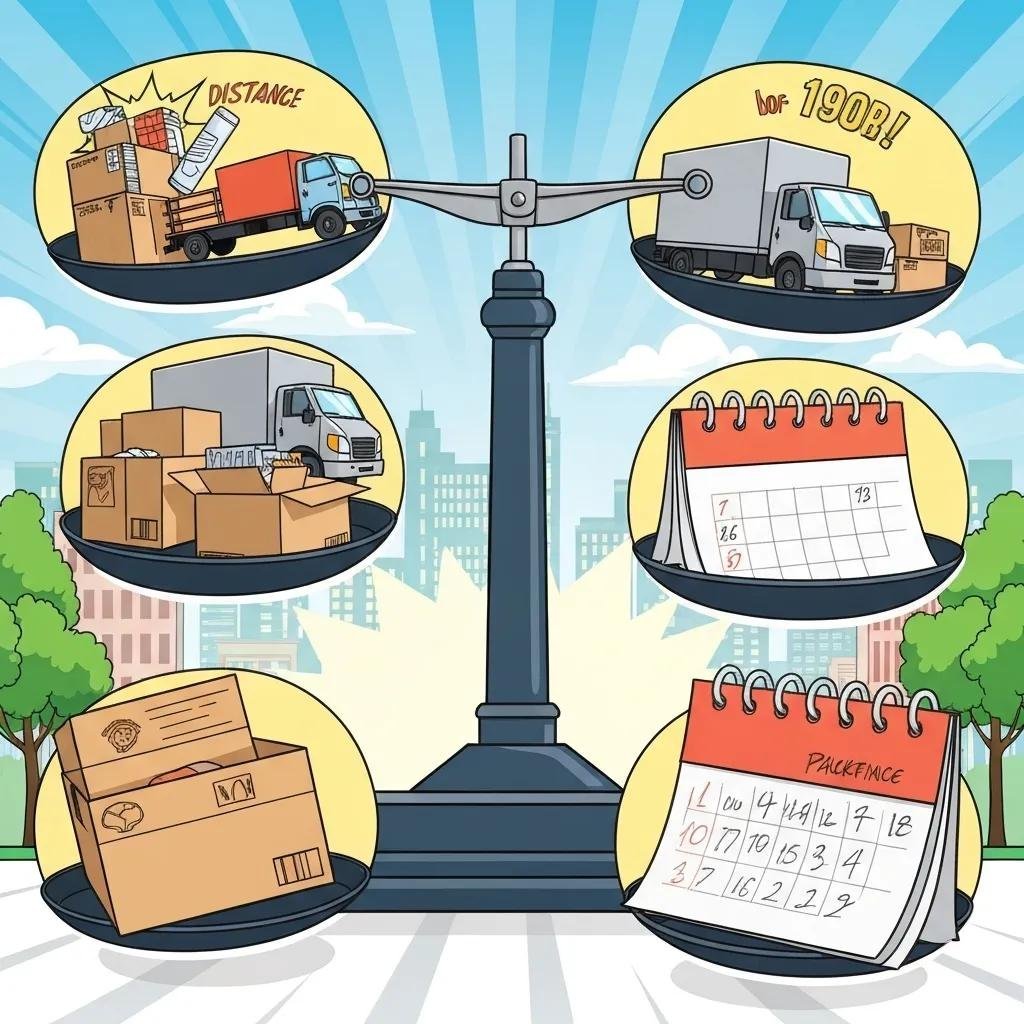Long-Distance Relocation Services That Simplify Your Move

Long-Distance Relocation Services That Simplify Your Move
Relocating across state lines involves coordinating dozens of details—from securing permits to packing fragile heirlooms—yet long-distance relocation services streamline every phase with expert planning, professional packing, secure transport, and on-site delivery. Readers will learn what defines an interstate move, how costs break down, essential planning steps, service options, and tracking and protection strategies to ensure a stress-free experience. This guide integrates actionable insights, cost-management tips, preparation checklists, service comparisons, and technology-driven tracking solutions to make your next long-distance move as seamless as possible.
What Are Long-Distance Relocation Services and How Do They Work?
Long-distance relocation services coordinate the inventory, secure packing, transportation, and unloading of household goods across significant distances, typically over 100 miles or state lines, by leveraging specialized fleets and experienced crews to guarantee safe, timely delivery and reduce relocation stress. These services begin with an on-site or virtual survey, proceed through professional packing and loading using industry-grade materials, transit via GPS-monitored vehicles, and conclude with careful unloading and setup at the destination. Integrating comprehensive insurance options and regulatory compliance ensures customers can focus on settling in rather than logistics and liability.
What Defines a Long-Distance Move or Interstate Moving Service?
A long-distance move or interstate moving service covers any relocation crossing one or more state boundaries or spanning more than 100 miles, triggering Federal Motor Carrier Safety Administration (FMCSA) registration and specific insurance and licensing requirements.
- Distance threshold: Moves beyond 100 miles or across state lines.
- Regulatory scope: FMCSA oversight for interstate carriers.
- Service scale: Requires dedicated trucks and long-haul logistics teams.
These criteria distinguish long-distance relocations from local moves, establishing specialized planning and compliance standards that guarantee protection and accountability throughout extended transit.
By understanding these regulations, you can avoid fines, delays, and liability gaps, ensuring legal compliance and peace of mind throughout your move.
How Does Professional Long-Distance Moving Simplify Your Relocation?

Professional long-distance movers remove the burden of manual labor, packaging, and coordination by providing end-to-end relocation management that enhances efficiency and safeguards possessions.
- Expert packing: Industry-grade materials protect fragile, bulky, and specialty items.
- Coordinated logistics: Scheduled pickups and deliveries align with your timeline.
- Insurance coverage: Customized valuation protection options minimize risk.
By delegating every aspect—from furniture disassembly to final placement—customers save time, reduce injury risk, and enjoy peace of mind during interstate relocation.
What Are the Key Steps in a Long-Distance Moving Process?
A structured long-distance moving process unfolds in four essential phases to ensure clarity, efficiency, and accountability from origin to destination.
Long-Distance Move Costs Guide - Horizon Boston Movers | Movers Boston
Long-distance move costs vary widely—typically ranging from $2,000 to $7,000 or more—because pricing models account for mileage, shipment weight or volume, chosen service level, and seasonal demand. Movers calculate charges based on distance traveled, cubic footage or weight of belongings, labor hours, and any add-on services like packing or storage, enabling customers to budget accurately and compare providers effectively.
Understanding Long-Distance Moving Costs and Influencing Factors
The cost of a long-distance move typically ranges from $2,000 to $7,000 or more, influenced by factors such as the distance traveled, the total weight or volume of belongings, the chosen service level (e.g., full-service vs. DIY), and seasonal demand. Peak moving seasons, like summer, often result in higher prices, potentially 10% higher than off-peak times.
This research provides a comprehensive overview of the primary cost drivers and typical price ranges for long-distance moves, directly supporting the article’s section on moving costs.
This research provides a comprehensive overview of the primary cost drivers and typical price ranges for long-distance moves, directly supporting the article’s section on moving costs.
What Are the Main Cost Drivers for Long-Distance Moving?

The primary cost drivers for an interstate relocation include:
- Distance traveled and route complexity.
- Total weight or volume of goods shipped.
- Service tier (full-service packing vs. DIY loading).
- Seasonal peaks and demand fluctuations.
- Additional services (storage, specialty handling, insurance).
Understanding these drivers empowers you to optimize your move by decluttering, scheduling off-peak departures, or selecting tailored service packages.
How Can You Get Accurate Long-Distance Moving Quotes?
Securing precise quotes involves several best practices to ensure transparency and avoid hidden fees:
- Provide a detailed inventory list with approximate weights.
- Request on-site or virtual surveys for precise measurements.
- Compare at least three written estimates from reputable carriers.
- Confirm which services and insurance options are included.
- Review cancellation and change-order policies for flexibility.
A clear, itemized estimate helps you select the right provider and manage your relocation budget with confidence.
What Are Affordable Long-Distance Moving Solutions and Options?
Moving teams and DIY models offer varying cost savings and convenience, allowing you to balance expenditure and effort based on priorities.
How Do You Plan and Prepare for a Stress-Free Long-Distance Move?
Effective long-distance move planning centers on clear timelines, systematic organization, and proactive coordination of logistics, paperwork, and service appointments to reduce last-minute challenges and ensure a seamless transition.
What Should Be Included in a Long-Distance Moving Checklist?
A comprehensive moving checklist aligns every task with your timeline and prevents oversight:
- Book your moving company and confirm dates.
- Notify utilities, postal services, and change-of-address.
- Purge unwanted items and arrange donations or sales.
- Gather high-quality packing supplies and labels.
- Create a room-by-room inventory with photos.
- Confirm insurance coverage and regulatory permits.
Adhering to this checklist keeps your relocation on schedule and prepares you for each milestone.
What Are Expert Packing Tips for Long-Distance Moves?
Proper packing techniques protect belongings through extended transit and multiple handling stages:
- Use double-walled boxes rated for long-haul transport.
- Wrap fragile items in bubble wrap or foam padding.
- Label each box with contents, destination room, and orientation.
- Disassemble bulky furniture and secure hardware in labeled bags.
- Store electronics in original boxes or custom-fit containers.
These strategies reduce damage risk and simplify unloading at your destination, setting the stage for a smooth arrival.
How Do Interstate Moving Regulations Impact Your Move?
Interstate relocations must comply with FMCSA rules, state-by-state licensing, and insurance requirements to protect consumers and carriers alike. Carriers operating across state lines register with the FMCSA, maintain minimum liability coverage, and adhere to weight and route restrictions. Understanding these regulations avoids fines, delays, and liability gaps, ensuring legal compliance and peace of mind throughout your move.
Federal Regulations and Consumer Protection in Interstate Moving
Interstate long-distance moves are regulated by the Federal Motor Carrier Safety Administration (FMCSA), an agency of the U.S. Department of Transportation. These regulations require moving companies to register with the FMCSA, obtain a USDOT number, carry liability and cargo insurance, and provide consumers with essential information like the “Your Rights and Responsibilities When You Move” handbook. The FMCSA also enforces rules regarding estimates, bills of lading, and a complaint process to protect consumers from fraud and disputes.
This information directly supports the article’s discussion on what defines an interstate move, the regulatory scope, and how interstate moving regulations impact the move, emphasizing consumer protection.
This information directly supports the article’s discussion on what defines an interstate move, the regulatory scope, and how interstate moving regulations impact the move, emphasizing consumer protection.
What Types of Long-Distance Moving Services Are Available?
Providers offer a spectrum of service tiers and specialties to match diverse relocation needs, budgets, and timelines, ensuring every customer can find a solution that balances convenience, cost, and care.
What Is Included in Full-Service Long-Distance Moving?
Full-service moves encompass every relocation task, eliminating manual labor and coordination burdens:
- Detailed pre-move surveys and scheduling.
- Professional packing of all household items.
- Secure loading using lift gates and climate-controlled trailers.
- Interstate transportation with real-time tracking.
- Unloading, unpacking, and furniture reassembly.
How Does Containerized Long-Distance Moving Work?
Containerized long-distance moving delivers a portable storage unit to your origin address, which you pack at your own pace before the carrier transports it to your destination and places it for unloading. This DIY-friendly model combines flexibility with cost savings and offers secure, weather-resistant containers that remain sealed throughout transit.
How Are Specialty Items and Vehicle Transport Handled?
Specialty items—including pianos, fine art, antiques, and vehicles—require tailored handling protocols to ensure safe passage across long distances:
- Custom-built crates and climate-controlled compartments.
- Hydraulic lift gates for heavy or irregular loads.
- Secure tie-down systems and airbags for vehicle transport.
How Can You Track and Protect Your Long-Distance Move?
Real-time visibility and comprehensive protection plans build trust and minimize risk during every mile of your relocation journey.
What Technology Is Available to Track Your Long-Distance Move?
Modern carriers integrate multiple technology platforms for transparent shipment monitoring:
- GPS-enabled trucks streaming real-time location updates.
- Mobile apps with inventory photographs and status notifications.
- Virtual surveys using 3D scanning to confirm packing accuracy.
What Moving Insurance and Protection Plans Should You Consider?
Choosing the right protection plan secures your investment against unforeseen events:
Selecting an appropriate plan ensures full peace of mind throughout the transit and delivery process.
How Do You Unpack and Settle In After a Long-Distance Move?
A strategic unpacking sequence expedites home setup and restores normalcy quickly:
- Begin with essential rooms—kitchen, bathrooms, bedrooms.
- Check each box against your inventory list and inspect for damage.
- Dispose or recycle packing materials responsibly.
- Reconnect electronics, appliances, and utilities first.
- Review your insurance policy for any freight claims.
This room-by-room approach turns a mountain of boxes into a welcoming home in record time.
For reliable support throughout your interstate relocation, consider partnering with a trusted provider like Movers Boston – Local and Long Distance Moving Company to access professional teams, transparent pricing, and comprehensive service packages.
A well-chosen long-distance relocation service transforms a complex move into a seamless experience, combining expert planning, secure transport, cost transparency, and advanced tracking to help you focus on the excitement of settling into your new home. Smooth execution hinges on understanding service options, managing costs, and preparing thoroughly, ensuring every aspect—from packing to insurance protection—is handled with precision and care.


